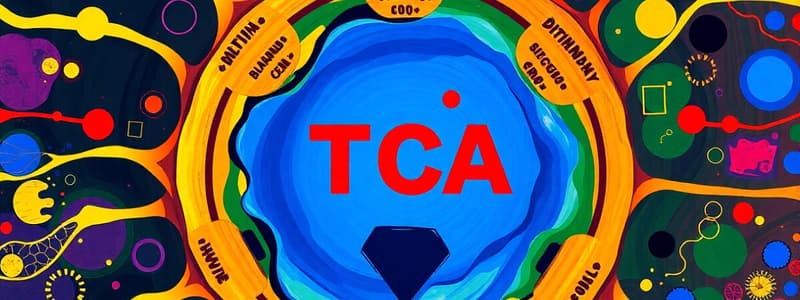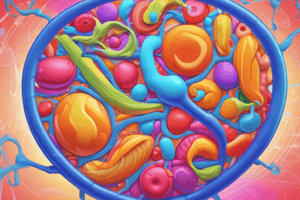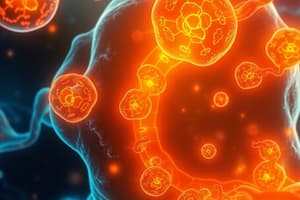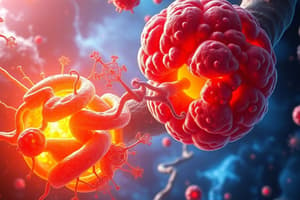Podcast
Questions and Answers
Why is the inner mitochondrial membrane less permeable compared to the outer membrane?
Why is the inner mitochondrial membrane less permeable compared to the outer membrane?
- To prevent the entry of pyruvate into the mitochondria.
- To facilitate the rapid diffusion of CO2 out of the matrix.
- To maintain the electrochemical gradient necessary for ATP synthesis. (correct)
- To allow for the unhindered passage of acetyl-CoA into the matrix.
Which molecule initiates the TCA cycle after CoA is removed?
Which molecule initiates the TCA cycle after CoA is removed?
- Citrate
- Oxaloacetate
- Pyruvate
- Acetyl (correct)
What happens to the carbon atoms from acetyl-CoA as the TCA cycle progresses?
What happens to the carbon atoms from acetyl-CoA as the TCA cycle progresses?
- They are incorporated into glucose molecules.
- They are used to synthesize fatty acids.
- They are stored in the mitochondrial membrane.
- They are released as CO2. (correct)
Under what conditions is FAD reduced to FADH2 in the TCA cycle?
Under what conditions is FAD reduced to FADH2 in the TCA cycle?
How many net ATP molecules are ultimately produced from one molecule of Acetyl-CoA going through the TCA cycle, including post-TCA cycle steps like oxidative phosphorylation?
How many net ATP molecules are ultimately produced from one molecule of Acetyl-CoA going through the TCA cycle, including post-TCA cycle steps like oxidative phosphorylation?
What is the immediate role of GTP produced during substrate-level phosphorylation in the TCA cycle?
What is the immediate role of GTP produced during substrate-level phosphorylation in the TCA cycle?
What is the consequence of oxygen (O2) deficiency on the TCA cycle and electron transport chain (ETC)?
What is the consequence of oxygen (O2) deficiency on the TCA cycle and electron transport chain (ETC)?
What is the primary role of TOMs (Translocase of the Outer Membrane) in mitochondrial function?
What is the primary role of TOMs (Translocase of the Outer Membrane) in mitochondrial function?
What happens to the CoA molecule when acetyl-CoA enters the TCA cycle?
What happens to the CoA molecule when acetyl-CoA enters the TCA cycle?
In what part of the mitochondria does the Krebs cycle take place?
In what part of the mitochondria does the Krebs cycle take place?
How many molecules of $CO_2$ are produced per molecule of acetyl that enters the TCA cycle?
How many molecules of $CO_2$ are produced per molecule of acetyl that enters the TCA cycle?
What is the role of TIMs (Translocase of the Inner Membrane) in mitochondrial function?
What is the role of TIMs (Translocase of the Inner Membrane) in mitochondrial function?
What is the main role of NADH and FADH2 in the Krebs cycle?
What is the main role of NADH and FADH2 in the Krebs cycle?
Where does the conversion of pyruvate to acetyl-CoA occur, and is this step part of the TCA cycle?
Where does the conversion of pyruvate to acetyl-CoA occur, and is this step part of the TCA cycle?
Besides Acetyl-CoA, what other product is produced with the conversion of Pyruvate?
Besides Acetyl-CoA, what other product is produced with the conversion of Pyruvate?
Flashcards
Intermembrane Space
Intermembrane Space
The space between the inner and outer mitochondrial membranes.
Mitochondrial Matrix
Mitochondrial Matrix
The space within the inner mitochondrial membrane.
TOMs
TOMs
Translocators located on the mitochondrial outer membrane, less specific.
TIMs
TIMs
Signup and view all the flashcards
Acetyl-CoA in TCA Cycle
Acetyl-CoA in TCA Cycle
Signup and view all the flashcards
CO2 Production in TCA Cycle
CO2 Production in TCA Cycle
Signup and view all the flashcards
Reduced Coenzymes
Reduced Coenzymes
Signup and view all the flashcards
GTP to ATP conversion
GTP to ATP conversion
Signup and view all the flashcards
Effect of no O2 on ETC and TCA Cycle
Effect of no O2 on ETC and TCA Cycle
Signup and view all the flashcards
Pyruvate to Acetyl-CoA
Pyruvate to Acetyl-CoA
Signup and view all the flashcards
Study Notes
-
Mitochondria possess two membranes with the intermembrane space located between them
-
The matrix is the space enclosed by the inner membrane.
-
The outer mitochondrial membrane is more permeable compared to the inner membrane
-
TOMs (translocators of the outer membrane) are less specific in their function
-
TIMs (translocators of the inner membrane) facilitate transport across the inner membrane.
-
The inner membrane's lower permeability aids in establishing an electrochemical gradient.
-
The TCA cycle's final product is identical to its initial substrate, hence the name "cycle"
-
Acetyl coA is the primary input for the TCA cycle
-
Upon entering the cycle, acetyl coA loses its coA component, leaving only acetyl
-
During the cycle, acetyl loses its carbon atoms in the form of CO2
-
Since acetyl consists of two carbon atoms, two CO2 molecules are produced
-
Three NADH molecules are generated during substrate conversion in the cycle
-
FAD is reduced to FADH2 when insufficient energy is released during conversions
-
NADH and FADH2 are referred to as reduced coenzymes.
-
ATP is produced via substrate-level phosphorylation
-
GDP is converted to GTP, which then donates a phosphate group to ADP, forming one ATP molecule
-
A total of 38 ATP molecules are produced
-
The ETC halts when O2 is absent, leading to an accumulation of FADH2 and NADH, along with a deficiency of NAD and FAD
-
Consequently, the Krebs cycle also ceases to function
-
Pyruvate converts to Acetyl coA within the mitochondria, but this step is distinct from the TCAC
-
During this conversion, CO2 and NADH are generated.
Studying That Suits You
Use AI to generate personalized quizzes and flashcards to suit your learning preferences.




